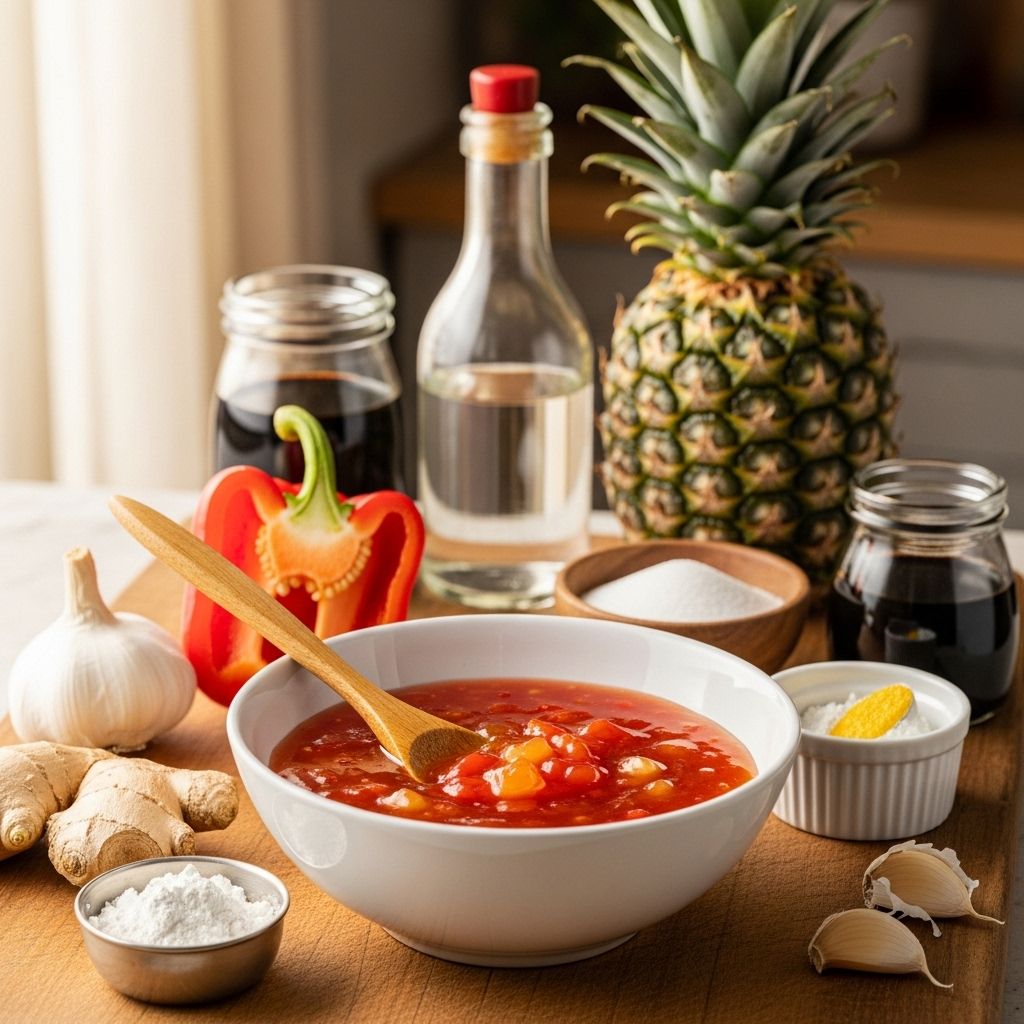Sweet And Sour Sauce: Step-By-Step Homemade Guide
Pantry basics transform into a condiment that elevates dishes with vibrant taste.

Mastering Sweet and Sour Sauce: A Complete Homemade Guide
Sweet and sour sauce is a vibrant, flavorful addition to countless dishes—synonymous with crispy appetizers, stir-fried classics, and timeless takeout favorites. While bottled versions abound, nothing compares to the punchy, customizable results you can achieve at home. This guide walks you through the essential techniques, ingredients, variations, and tips for preparing authentic sweet and sour sauce from scratch.
What Is Sweet and Sour Sauce?
Sweet and sour sauce is a classic condiment rooted in Chinese cuisine. Known for its striking red hue and its balance of tangy and sugary notes, the sauce is a staple in both everyday dishes and festive meals. Traditionally made with just a handful of pantry ingredients, it’s endlessly adaptable and incredibly easy to make.
- Sweet: Achieved primarily through sugar and sometimes ketchup
- Sour: Balanced by vinegar (often white or apple cider)
- Optional: Pineapple, bell peppers, or chili flakes for flavor variations
Why Make Sweet and Sour Sauce at Home?
Homemade sweet and sour sauce delivers fresher, more defined flavors than bottled alternatives. You have complete control over sweetness, sourness, thickness, and spice. Plus, without preservatives or artificial colorings, the sauce tastes brighter and healthier. The process is simple, requiring only a few common ingredients and a quick stovetop simmer.
Essential Ingredients
The best sweet and sour sauces rely on simplicity. While restaurants may include pineapple or sautéed vegetables, a traditional sauce sticks to core pantry basics. Here’s what you’ll need:
| Ingredient | Purpose |
|---|---|
| Sugar | Core sweetness |
| Ketchup | Sweetness & color |
| Vinegar | Sour balance |
| Soy Sauce | Umami depth |
| Cornstarch | Thickening |
| Water | Base |
Optional: Try using apple cider vinegar for a fruitier note, or chili flakes for heat.
Step-by-Step Recipe: Classic Sweet and Sour Sauce
This recipe creates vibrant, restaurant-style sauce with just a handful of ingredients. Follow these steps for perfect results:
- Mix Base Ingredients: In a saucepan, combine sugar, ketchup, vinegar, soy sauce, and a splash of water.
- Heat and Whisk: Place the pan over medium heat. Whisk continuously until the sugar fully dissolves and the ingredients are thoroughly combined.
- Add Thickener: In a separate bowl, dissolve cornstarch in a little cold water to form a slurry. Gradually pour the slurry into the warm sauce, stirring briskly.
- Simmer to Desired Thickness: Continue heating for 1–2 minutes, stirring, until the mixture thickens into a glossy, saucy consistency. Avoid overcooking—stop once it pours smoothly but clings to food.
- Adjust Flavors: Taste and adjust sweetness or sourness to your liking by adding more sugar or vinegar as desired.
- Cool and Serve: Serve warm as a dip, pour over cooked dishes, or refrigerate for later use.
Ingredient Tips and Variations
- Chili Flakes: For a spicy kick, add 1/4 teaspoon of crushed chili flakes during simmering.
- Pineapple Juice: Substitute part of the water for pineapple juice to achieve a tropical sweetness.
- Vinegar Variety: Use apple cider vinegar for a mellower, fruitier sour note. White vinegar brings sharper tang.
- Ketchup Quality: Choose your preferred brand—organic, low sugar, or classic—for subtle differences in flavor and color.
What Makes This Version Stand Out?
This recipe trims traditional sweet and sour sauce down to its essentials—no pineapple chunks, no peppers to chop. The focus is on a clean, bright sugar-vinegar profile that comes together in minutes. By skipping cumbersome steps, the sauce is accessible to cooks of any skill level and works in any kitchen, whether for a quick weeknight meal or a crowd-pleaser at parties.
How to Serve Sweet and Sour Sauce
Its versatility is part of what makes sweet and sour sauce iconic. Try these serving ideas to get the most out of your batch:
- Dipping: Perfect alongside spring rolls, wontons, dumplings, chicken nuggets, or fried wontons.
- Stir-Fry: Toss with crispy pork or chicken and stir-fried vegetables for a restaurant-style entrée.
- Drizzling: Pour over steamed fish, grilled shrimp, or tofu for an instant flavor upgrade.
- Glaze: Brush onto skewers, ribs, or grilled meats in the last minutes of cooking.
Storage and Make-Ahead Tips
- Refrigerate: Store cooled sauce in an airtight jar for up to one week.
- Reheat: Gently warm over low heat or in short microwave bursts; stir well before serving for the smoothest texture.
- Flavor Improves: Allowing the sauce to rest overnight deepens flavors as the ingredients meld.
- Freezing Not Recommended: Cornstarch-thickened sauces may separate when frozen and thawed. For longer storage, prepare just the base without the thickener; freeze and add slurry after reheating.
Common Problems and Solutions
- Sauce Too Thick: Whisk in a little water, a tablespoon at a time, until pourable.
- Sauce Too Thin: Simmer for 30–60 seconds longer or add a bit more cornstarch slurry and bring back to a simmer.
- Too Sweet or Too Tart: Adjust by stirring in a teaspoon of vinegar for tartness or sugar for additional sweetness.
- Jelly-Like Texture: Boiling after thickening can cause the sauce to set like jelly. Remove from heat as soon as it thickens.
Nutrition and Dietary Adaptations
- Gluten-Free: Use gluten-free tamari instead of soy sauce.
- Vegan: All standard ingredients in this sauce are plant-based.
- Low Sugar: Swap part of the sugar for a zero-calorie sweetener or use a low-sugar ketchup.
Frequently Asked Questions (FAQs)
What is sweet and sour sauce made of?
Traditional sweet and sour sauce combines sugar, vinegar, ketchup, soy sauce, cornstarch, and water. Additional seasonings or fruit juices may be added for variation.
How can I thicken my sweet and sour sauce?
Use a cornstarch slurry: mix cornstarch with cold water, add it to the simmering sauce, and cook until it reaches your desired consistency.
Why did my sauce become jelly-like or stiff?
Overcooking after adding the cornstarch can cause the mixture to firm up excessively. Remove from heat as soon as it thickens and store it warm.
Can sweet and sour sauce be made ahead of time?
Absolutely. In fact, the sauce tastes even better after resting overnight in the refrigerator, as the flavors deepen and harmonize.
What dishes pair best with sweet and sour sauce?
Dipping favorites like fried wontons, chicken strips, tofu bites, won ton, and egg rolls; drizzled over stir-fried meats or vegetables; or brushed onto grilled skewers or fried fish.
Creative Variations
Once you’ve mastered the basics, experiment with these creative ways to customize your sauce:
- Ginger-Garlic: Add minced fresh ginger or garlic to the simmer for aromatic depth.
- Fruit Forward: Stir in a splash of orange juice or pineapple juice for brighter fruit presence.
- Spicy: Increase chili flakes or a dash of hot sauce for fiery versions.
- Sesame: Stir in a teaspoon of toasted sesame oil after removing from heat for a nutty finish.
Simple Sweet and Sour Sauce Recipe (Printable)
Ingredients: - 4 tbsp sugar - 2 1/2 tbsp ketchup - 3 tbsp vinegar (white or apple cider) - 2 tbsp soy sauce - 3/4 cup water - 1 tbsp cornstarch (dissolved in 2 tbsp cold water) Method: 1. In a saucepan, combine sugar, ketchup, vinegar, soy sauce, and water. 2. Heat over medium, whisking until sugar dissolves. 3. Stir in the cornstarch slurry and cook until thickened. 4. Remove from heat and let cool slightly before serving or storing. Final Notes
With just pantry staples and a few easy techniques, you can master the art of sweet and sour sauce—a bright, bold accent for all your favorite meals. Whether for dipping, tossing, or glazing, this homemade version brings unbeatable flavor, versatility, and satisfaction every time you cook.
Read full bio of Srija Burman












